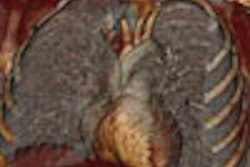CHICAGO - Due to its superior z-axis resolution, 64-slice CT may do a better job than 16-slice in detecting in-stent stenosis, researchers reported on Sunday at the RSNA meeting. The study found the greatest advantage for 64-slice when the stent was parallel to the x-ray beam.
Another group found that 64-slice CT did not visualize vessels significantly better than 16-slice, but did improve diagnostic accuracy.
"In recent years the number of coronary catheterizations resulting from the diagnosis of coronary heart disease has been rising steadily," said Dr. Harald Seifarth from the University of Muenster in Germany in a Sunday presentation. "In 2002 in the U.S. alone, 540,000 stents have been placed, necessitating an effective tool for follow-up of these patients, even if the new drug-eluting stents have a relatively low restenosis rate."
A few studies have shown that direct visualization of in-stent stenosis is possible, but it remains difficult to accomplish in the clinical setting, he added.
The group built a vascular phantom to compare the two scanners (Sensation 16 and Sensation 64, Siemens Medical Solutions, Erlangen, Germany). Fifteen different stents, mainly of cobalt-chromium alloy or stainless steel, were filled with candle wax to simulate in-stent stenoses of 50% to 60%. The stents were then placed into a plastic tube filled with diluted contrast media (250 HU), sealed and immersed in oil to simulate epicardial fat.
The tubes were imaged using the 16- and 64-slice scanners (16 x 0.75 mm, 550 mAs, 120 kVp; and 64 x 0.6 mm, 680 mAs, 120 kVp, respectively) at orientations of 0°, 45°, and 90° relative to the scanners' z-axis. Reconstructions of 1-mm thickness were created using a high-resolution kernel and 50% overlapping sections.
"For the evaluation we created MPRs (multiplanar reconstructions) along and perpendicular to the stent axis," Seifarth said. "We measured the visible lumen diameter and visible attenuation inside the stent lumen." Three readers then evaluated the delineation of in-stent stenosis using a five-point scale, with 4 representing visible stenosis.
For 16-slice CT the mean visible lumen diameters were 1.73 mm, 1.56 mm, and 1.68 mm compared to 1.83 mm, 1.88 mm, and 1.92 mm for 64-slice CT at orientations of 0°, 45°, and 90° relative to the z-axis, Seifarth reported. The differences between 16- and 64-slice CT were statistically significant at all orientations.
Moreover, the attenuation differences between the stented and unstented portions of the tube were significantly lower in 64-slice CT, and "always closer to the true vascular attenuation of 250 HU," he said. Mean attenuation within the stent lumen was 311 HU, 353 HU, and 363 HU for 16-slice CT and 199 HU, 229 HU, and 252 HU for 64-slice CT at the orientations reported hereinabove.
The mean visibility scores (scale 0-5) for in-stent stenosis and residual stent lumen were 2.2, 2.4 for 16-slice CT and 2.6, 3.4 for 64-slice CT at 0° and 90°, respectively.
"With 16-slice CT you can guess that there must be some soft-density material within the z-lumen," Seifarth said of one example, "but when you move to 64-slice CT you can see the soft plaque material here and also the patent lumen here, and that's especially true when the stent is oriented perpendicular to the z-axis, which is the case with most stents...."
Due to higher z-axis resolution, use of 64-slice CT results in superior visualization of the stent lumen and in-stent stenosis compared to 16-slice CT, especially when the stent is perpendicular to the z-axis, he noted.
"But blooming artifacts still remain an important problem and they obscure up to 30% of the stent lumen even with the newest scanner generation," Seifarth said.
In another study presented during the same session, 64-slice scanners did not significantly improve the visualization of vessels 2 mm and larger compared to 16-slice, but did significantly improve diagnostic accuracy when the smaller coronary branches and greater degrees of wall calcification were included.
Dr. F. Pugliese and colleagues from Erasmus Medical Center in Amsterdam compared different generations of MDCT scanners for assessing coronary artery disease in 153 patients who underwent CT angiography, the group reported in an abstract.
In the study, 51 patients were examined with 16-sliced MDCT (rotation speed 420 msec); 51 patients were scanned with ultrafast 16-slice MDCT (rotation speed 375 msec); and a third group underwent 64-slice CTA (rotation speed 330 msec).
Patient profiles were similar for all three groups (mean heart rate 57 bpm), although vessel wall calcification was less extensive in the ultrafast 16-slice group. For detecting coronary artery disease, sensitivity was 92% for 16-slice CT and 95% for ultrafast 64-slice CT, while specificity was the same for both at 93%. The positive predictive values were 64% and 99% for 16-slice CT and 64-slice CT, respectively; the negative predictive values were 69% and 99%, respectively, the researchers reported.
By Eric Barnes
AuntMinnie.com staff writer
November 27, 2005
Related Reading
Cardiac CT strategies cut dose, keep image quality, November 25, 2005
Coronary calcium screening seen useful beginning between age 40 and 50, September 23, 2005
Contrast delivery key in coronary CTA, September 7, 2005
Low-dose CT calcium scores near-equivalent of higher dose, September 20, 2005
Copyright © 2005 AuntMinnie.com




















